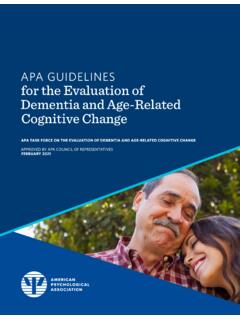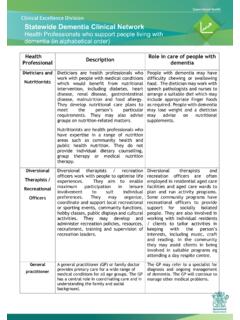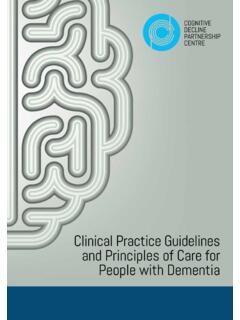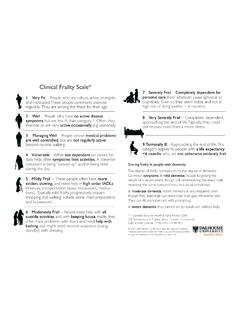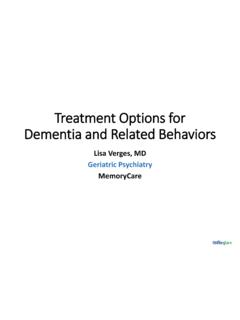Transcription of Palliative Care Guidelines In Dementia - NHS England
1 March 2018 Review Date: 2020 Palliative care Guidelines In Dementia 2nd Edition North West Coast Strategic clinical Network Page 2 of 90 Palliative care Guidelines in Dementia 2nd Edition Version March 2018 Contents 1. Introduction .. 5 2. Descriptions of the Dementia Syndromes .. 7 3. Assessment in Dementia and End of Life .. 13 4. Communication .. 22 5. Therapeutic Interventions in Dementia .. 26 6. General Considerations for Medicines Management in People with Dementia .. 33 7. Living with Dementia : A guide to the care Act 2014 and the Impact on Local Authority Provision, Continuing Health care and Finances .. 39 8. Spirituality and People with Advanced Dementia .
2 45 9. The Mental Capacity Act 2005 .. 48 10. Advance care Planning .. 56 11. Clinically Assisted Nutrition and Hydration in People with Dementia .. 59 12. Treating Infection in End Stage Dementia .. 65 13. Identifying Dying in Advanced Dementia .. 67 14. Rationalisation of Medication in Advanced Dementia .. 71 15. Caring for a person with Dementia in the final days of life .. 75 16. Bereavement .. 81 17. Carers Health and Wellbeing .. 84 18. Useful Resources .. 88 Members of the Working Party .. 90 North West Coast Strategic clinical Network Page 3 of 90 Palliative care Guidelines in Dementia 2nd Edition Version March 2018 Foreword In 1995, I was working as a registrar in old age psychiatry in a large hospital which had long stay psychogeriatric beds.
3 Having previously spent time working in a hospice and oncology, I was keen to make a difference to those patients with Dementia who were coming to the end of their lives. The clinical staff were totally committed, and in a small way, I was allowed and encouraged to make a difference to how patients were being cared for, in terms of pain relief and what may be termed comfort care . During that time, with the support of senior staff, I carried out a small audit of the Palliative care for people dying with Dementia on the long stay wards. This was published (Lloyd-Williams 1996) and was also presented at a national Palliative care conference at the end of my presentation there were no questions and the chair at the time, made the comment, that he was very surprised I had been selected to present such a topic in a Palliative care meeting!
4 Twenty one years later, I am delighted that Palliative care for Dementia is now high on the Palliative care agenda with hospices and Palliative care teams working alongside nursing homes to facilitate care , initiatives such as the Dementia End of Life Programme within the End of Life Partnership, Hospices embracing Dementia as part of their remit and families of people dying with Dementia , being supported. However there is still much to be done and it is easy for those of us working within the area where we strive for best practice, to sometimes forget, that we need to constantly share good practice, work alongside our acute, primary care and care home colleagues and as always learn so much from them as well as sharing what we have collectively learnt.
5 When we come across a difficult clinical situation in what is often a hugely busy clinical setting, we need to be able to access information quickly and easily. These Palliative care Guidelines produced by the North West Coast Strategic clinical Network will be invaluable to us all as we come across situations that we may be uncertain about and as we work alongside others Professor Mari Lloyd-Williams, Professor and Director of Academic Palliative and Supportive care Studies Group, University of Liverpool References Lloyd-Williams M. An audit of Palliative care in Dementia . Eur J Cancer care (Engl). 1996 Mar;5(1):53-5 North West Coast Strategic clinical Network Page 4 of 90 Palliative care Guidelines in Dementia 2nd Edition Version March 2018 Advancing Dementia Good communication is important throughout Palliative care Guidelines in Dementia Quick Reference Guide Diagnosing Dementia can be challenging, considering the different Dementia syndromes (see page 7 of full Guidelines ) Loss of capacity can occur early following diagnosis or prior to this so it is important to consider early assessment of capacity (p 48) and advance care planning (p 56) Ongoing holistic assessment and a person-centred approach to care are essential (p 13)
6 Management of cognitive and non-cognitive symptoms can be challenging (p 24) and some medications should be avoided if possible in certain specific types of Dementia (p 33) Assessment of social care needs and understanding of the individual`s entitlement in light of the care Act 2014 are very important (p 39) Carers need access to ongoing support (p 40) and need to be given information about local services which they may find helpful to maintain their own health and wellbeing (p 84) Clinically assisted hydration/ nutrition (p 59), treatment of infection (p 69) and goals of care can be particularly challenging issues in patients with Dementia As the patient deteriorates it is important to rationalise medication and discontinue non-essential drugs, reducing the number and frequency to the minimum needed for comfort (p 71) Identifying dying can be difficult in people with Dementia (p 67) The 5 key priorities for care of the dying patient is a framework for holistic care of the patient in the final days and hours of life and those important to them (p 75) Carers should be able to access the appropriate level of bereavement support to meet their needs (p 82)
7 North West Coast Strategic clinical Network Page 5 of 90 Palliative care Guidelines in Dementia 2nd Edition Version March 2018 1. Introduction These Guidelines were first developed in 2011 in response to The Department of Health End of Life care Strategy (2008) to support professionals to provide the highest possible quality of end of life care to people with Dementia . When the first edition was published, there were just under 700,000 people living in the UK with Dementia . Today, that figure is now 850,000. This year, 225,000 people will develop Dementia , that s one person every three minutes. Dementia is described as a demographic time bomb with a dramatic projected increase in the number of people diagnosed with Dementia .
8 By 2025, it is predicted to affect over 1 million people and this is due to soar to 2 million by 2051 (Alzheimer s Society, 2016). Dementia is one of the main causes of disability later in life, ahead of cancer, cardiovascular disease and stroke and 30% of people aged 65 or over will die with Dementia (Dixon et al, 2015). Rates of diagnosis vary significantly across the UK. In England it is estimated that the average rate of Dementia diagnosis is 48% (Marie Curie, 2014). When made, diagnosis is most often: late in the illness at a time of crisis too late for effective intervention Although Dementia as a cause of death is increasing and the number of deaths with a mention of Dementia recorded on the death certificate increased from to in England between 2001 and 2010 (Sleeman et al, 2014) it is often not recognised as a life limiting condition.
9 People with Dementia may face additional complications at the end of their lives including diminishing mental capacity, difficulty in communicating needs such as pain and thirst, uncertainty in prognosis. Professionals may also lack the skills and confidence to deal with these challenges and services may not be available or suitable for people with Dementia (Alzheimer s Society, 2012). These Guidelines have been revised and updated to provide a practical resource for professionals who care for people with Dementia at the end of life. They have been devised to allow the professional to access the sections relevant to them at any given time. They are intended to provide an overview of the subject and are not meant as an exhaustive guide.
10 However, recognising that professionals will at times need more information, additional resources are cited throughout the Guidelines and in a section at the very end. In order to provide a structure to this guide, the sections have been organised in line with the North West End of Life care Model (The North West Palliative and End of Life care Operational Group, 2015). The model comprises of 5 phases to support the assessment and planning process for people from the diagnosis of a life limiting illness, as seen below: The North West End of Life care Model, North West Palliative and End of Life care Operational Group (2015) North West Coast Strategic clinical Network Page 6 of 90 Palliative care Guidelines in Dementia 2nd Edition Version March 2018 The Guidelines begin with an overview of different Dementia syndromes and considers a number of issues, such as assessment and communication, that have an impact on the person with Dementia even before the person may be considered to be in the last year of life.











